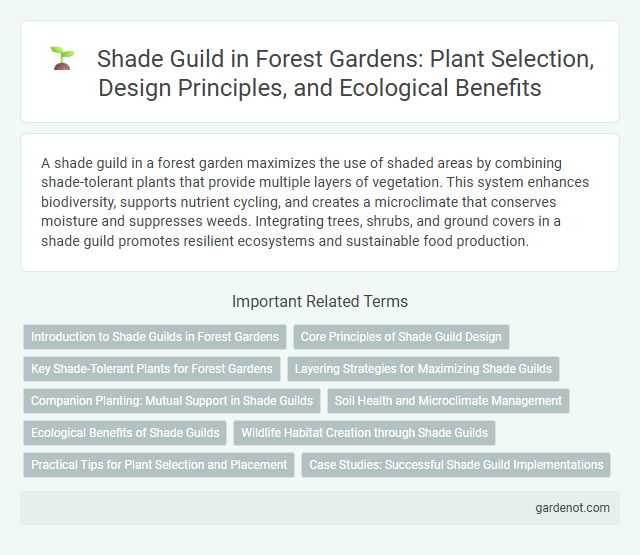A shade guild in a forest garden maximizes the use of shaded areas by combining shade-tolerant plants that provide multiple layers of vegetation. This system enhances biodiversity, supports nutrient cycling, and creates a microclimate that conserves moisture and suppresses weeds. Integrating trees, shrubs, and ground covers in a shade guild promotes resilient ecosystems and sustainable food production.
Introduction to Shade Guilds in Forest Gardens
Shade guilds in forest gardens are strategic plant communities designed to thrive under the canopy of larger trees, optimizing space and resources. These guilds typically include shade-tolerant species such as herbs, shrubs, and groundcovers that complement the dominant tree, enhancing biodiversity and soil health. Integrating shade guilds promotes microclimate regulation, reduces weed growth, and supports beneficial insect habitats, making them vital components of sustainable forest garden ecosystems.
Core Principles of Shade Guild Design
Shade guild design revolves around selecting complementary plant species that thrive under tree canopies while enhancing soil health, pest control, and biodiversity. Core principles include layering plants by height and root depth to maximize space and nutrient use, incorporating nitrogen-fixing and dynamic accumulator plants to enrich soil fertility naturally. Emphasizing native species and perennial plants ensures ecosystem resilience and sustainable forest garden productivity.
Key Shade-Tolerant Plants for Forest Gardens
Key shade-tolerant plants in forest garden shade guilds include ferns, hostas, and wild ginger, which thrive under dense tree canopies. These plants improve soil health through organic matter accumulation and nutrient cycling, supporting overall forest garden productivity. Integrating shade-tolerant species like Solomon's seal and Siberian iris enhances biodiversity while maximizing understorey space in shaded environments.
Layering Strategies for Maximizing Shade Guilds
Layering strategies in shade guilds maximize productivity by combining diverse plant heights and functions, ensuring optimal light capture and soil health. Canopy trees provide shade and fruit, while understory shrubs, herbs, and groundcovers occupy mid to lower layers, enhancing biodiversity and nutrient cycling. Incorporating nitrogen-fixing plants and deep-rooted species stabilizes the ecosystem and improves resilience within the forest garden.
Companion Planting: Mutual Support in Shade Guilds
Shade guilds in forest gardening utilize companion planting to create mutual support among species, optimizing growth and resource use under canopy shade. Key plants like nitrogen-fixing legumes, deep-rooted comfrey, and shade-tolerant herbs improve soil fertility, water retention, and pest control, fostering a resilient ecosystem. This synergistic plant combination enhances productivity while maintaining biodiversity and ecological balance in shaded environments.
Soil Health and Microclimate Management
Shade guilds in forest gardens enhance soil health by promoting nutrient cycling through deep-rooted companion plants that bring minerals to the surface. These plant layers create a microclimate that moderates temperature extremes, retains moisture, and reduces soil erosion, supporting robust microbial activity and organic matter decomposition. Effective microclimate management within the shade guild establishes a stable environment that boosts plant resilience and overall ecosystem productivity.
Ecological Benefits of Shade Guilds
Shade guilds enhance forest garden ecosystems by promoting biodiversity through layered plant structures that support various wildlife species. These guilds improve soil health by reducing erosion, increasing moisture retention, and fostering beneficial microbial activity. Their diverse plant composition also aids in pest management, reducing the need for chemical interventions and supporting sustainable agricultural practices.
Wildlife Habitat Creation through Shade Guilds
Shade guilds in forest gardens serve as vital wildlife habitats by providing diverse layers of vegetation that offer shelter, nesting sites, and food sources for various species. Integrating native trees, shrubs, and groundcovers within these guilds supports pollinators, birds, and beneficial insects, enhancing biodiversity and ecosystem resilience. Creating multifaceted shade guilds promotes natural pest control and soil health while fostering a sustainable habitat for local wildlife populations.
Practical Tips for Plant Selection and Placement
Choose shade-tolerant plants such as ferns, hostas, and lungwort for the shade guild to maximize growth under tree canopies. Place taller, nitrogen-fixing species like autumn berry or red elderberry near sunlit edges to improve soil fertility and provide partial shade. Position ground covers such as sweet woodruff or wild ginger close to tree trunks to reduce soil erosion and retain moisture effectively.
Case Studies: Successful Shade Guild Implementations
Case studies of successful shade guild implementations demonstrate enhanced biodiversity and improved crop yields in agroforestry systems. For example, the permaculture farm in Hawaii integrated nitrogen-fixing trees and shade-tolerant crops, resulting in healthier soils and increased food production. Similar projects in Mediterranean climates highlight the guild's role in water conservation and pest resistance, showcasing its adaptability across diverse ecosystems.
Shade guild Infographic

 gardenot.com
gardenot.com